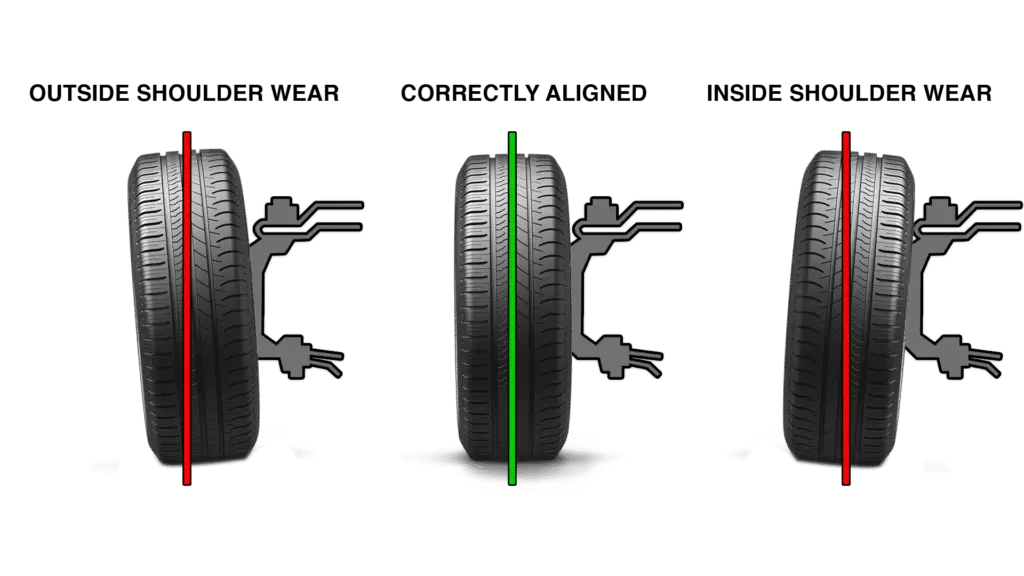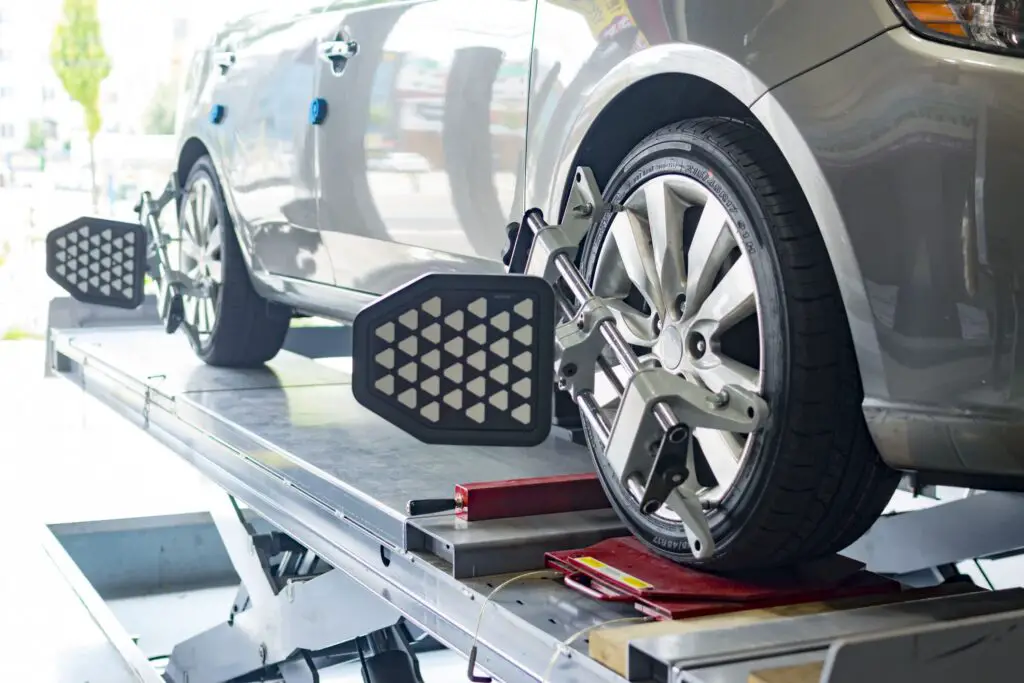Do I need a tire alignment? If you notice uneven tire wear, your steering wheel pulls to one side, or your vehicle vibrates at high speeds, it’s likely you need a tire alignment.
If you’ve been experiencing uneven tire wear, your steering wheel pulling to one side, or vibrations at high speeds, you may be wondering, “Do I need a tire alignment?” A tire alignment is an essential part of vehicle maintenance that can improve safety, extend the life of your tires, and make driving more comfortable.
In this article, we’ll explain the importance of tire alignments, how to know if you need one, the benefits of proper alignment, and how it’s done.

Contents
What Does Tire Alignment Mean?
Tire alignment, also known as wheel alignment, is the process of adjusting the angles of your vehicle’s tires to match the manufacturer’s specifications. This adjustment ensures that your tires meet the road at the correct angles, providing optimal contact and traction. Proper alignment also ensures that the vehicle’s steering, suspension, and handling are functioning correctly.
When your tires are properly aligned, they wear evenly, which improves handling, extends tire life, and promotes better fuel efficiency.
Why Is Tire Alignment Important?
Tires are the only part of your vehicle that makes direct contact with the road, so proper alignment is critical for optimal performance and safety. When tires are out of alignment, they can cause a variety of issues that affect your vehicle’s safety and longevity. The most noticeable effects are usually uneven tire wear, poor handling, and compromised fuel efficiency.
In addition to improving safety and comfort, tire alignment also helps your car perform better by keeping the wheels in the correct position, ensuring that your tires are properly inflated and making the best use of their tread.

How Do I Know If I Need a Tire Alignment?
If your vehicle is showing any of the following symptoms, it may be time for an alignment:
1. Uneven or Excessive Tire Wear
Uneven wear on your tires is one of the most common signs that the vehicle needs an alignment. If the tread is wearing more on one side of the tire than the other, or if the center of the tire is wearing faster than the edges, this could indicate an alignment problem.
2. Pulling to One Side
If your car consistently pulls to the left or right when you drive on a straight, level road, tires may not be aligned properly. This issue can also be caused by improperly balanced tires or uneven air pressure, but an alignment issue is often the culprit.
3. Vibrations While Driving
If you feel vibrations in the steering wheel or through the floor of the car, especially at higher speeds, it could indicate that the tires are misaligned. These vibrations occur because the misaligned tires are no longer rolling straight, causing an imbalance that you can feel in the car.
4. Crooked Steering Wheel
When you drive in a straight line and the steering wheel is tilted to one side, this is a clear sign of misalignment. If you need to keep the wheel at an angle to keep your vehicle moving straight, it’s time for an alignment.
5. Steering Wheel Off Center
If your steering wheel is not centered when you’re driving straight, or it doesn’t return to its normal position after turning, you may have an alignment issue. This can be a sign that one or more of your wheels is misaligned, causing improper steering responses.
What Causes Tire Misalignment?
Tire misalignment can happen for a variety of reasons. The most common causes include:
1. Potholes and Road Hazards
Hitting potholes, curbs, or road debris can cause significant damage to your vehicle’s alignment. These impacts can knock the suspension or steering components out of place, which leads to misalignment.
2. Worn Suspension Components
Vehicle’s suspension system helps absorb shocks from the road and keeps the wheels in proper alignment. If suspension components such as shocks, struts, or ball joints wear out, the alignment may be affected.
3. Accidents or Collisions
Any type of accident or collision, even a minor one, can knock your wheels out of alignment. It’s important to have your vehicle inspected after any kind of impact to ensure the alignment is still correct.
4. Normal Wear and Tear
Over time, the suspension system and other components of your vehicle naturally wear out. This can cause small shifts in alignment. Even though the effects may not be immediately noticeable, regular alignments can help prevent long-term issues.
Benefits of Regular Tire Alignment
Having your tires aligned regularly offers several benefits:
1. Improved Tire Lifespan
Proper alignment ensures that tires wear evenly, which can extend their life. Misaligned tires wear out more quickly, forcing you to replace them sooner than necessary.
2. Better Fuel Efficiency
When your tires are aligned properly, they experience less resistance while driving. This means your engine doesn’t have to work as hard to move the vehicle, improving your gas mileage and saving you money on fuel.
3. Improved Handling and Comfort
Properly aligned tires provide better control of your vehicle. It allows for smoother handling, reduces vibrations, and prevents your car from pulling to one side, providing a more comfortable and safe driving experience.
4. Enhanced Safety
Misalignment can compromise your ability to control the vehicle, especially in slippery or hazardous road conditions. Keeping your tires aligned ensures that your vehicle handles properly, which improves your overall safety on the road.
How Is Tire Alignment Done?
Tire alignment is typically performed by a mechanic at a professional auto service center. Here’s how the process works:
1. Inspection
The mechanic will inspect the tires, suspension, and steering components to check for wear or damage. This inspection may involve taking measurements of the angles of your tires and ensuring they match the manufacturer’s specifications.
2. Adjustment
Using a special machine, the mechanic will adjust the alignment of the wheels. This usually involves adjusting the camber, toe, and caster angles:
- Camber: The inward or outward tilt of the tires when viewed from the front.
- Toe: The alignment of the tires in relation to the centerline of the vehicle (i.e., how much the tires point inward or outward).
- Caster: The angle of the steering axis when viewed from the side of the vehicle.
3. Testing and Final Check
Once the adjustments are made, the mechanic will test-drive the vehicle to ensure that everything is functioning correctly. This includes checking for smooth steering and proper handling.
How Often Should I Get a Tire Alignment?
It’s generally recommended to have your tire alignment checked every 1-2 years. However, you should also have it inspected if:
- You notice any symptoms of misalignment (such as pulling to one side or uneven tire wear).
- You’ve recently hit a pothole or been in an accident.
- You’ve replaced parts of the suspension or steering system.
It’s also important to get your alignment checked when you install new tires, as misalignment can cause uneven wear on your new tires.
Frequently Asked Questions
Here are some FAQs about tire alignment –
1. Can I drive with bad alignment?
While it’s possible to drive with misaligned tires, it’s not recommended. Misalignment can cause uneven tire wear, reduced fuel efficiency, and poor handling, which can be dangerous.
2. How much does a tire alignment cost?
The cost of a tire alignment can vary depending on your vehicle, location, and the service provider. On average, it can range from $75 to $100 for a standard alignment.
3. Can I align just one tire?
No, tire alignments are performed on all four tires at once, as misalignment usually affects multiple tires simultaneously.
4. How long does a tire alignment take?
A typical tire alignment usually takes around 30 minutes to 1 hour, depending on the complexity of the alignment and the condition of the vehicle.
Conclusion
If you’ve noticed issues like uneven tire wear, a pulling steering wheel, or vibrations while driving, a tire alignment is likely necessary. Regular alignments are an essential part of vehicle maintenance, helping to improve tire life, fuel efficiency, and vehicle handling. Whether you drive an everyday commuter car or a performance vehicle, ensuring your tires are aligned properly is a key aspect of keeping the vehicle running safely and efficiently.